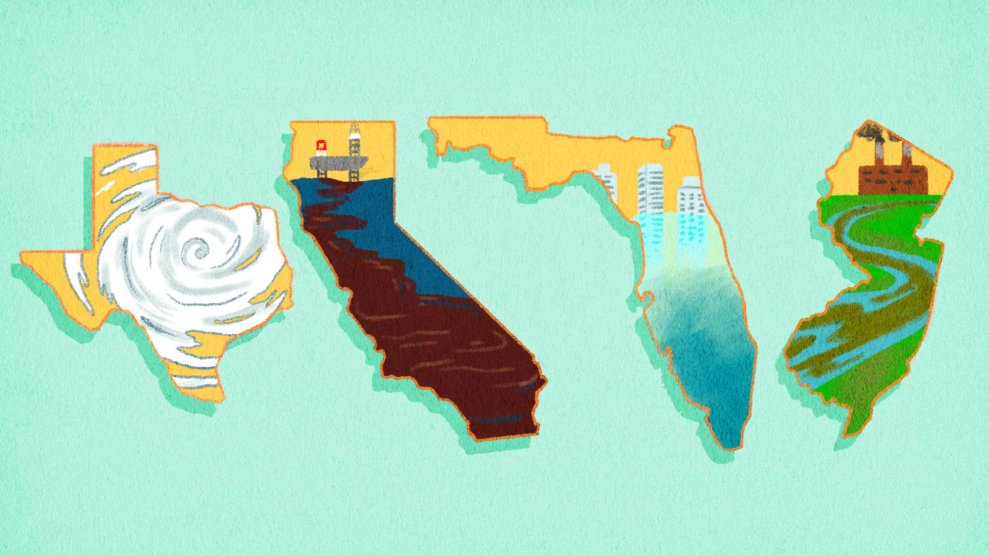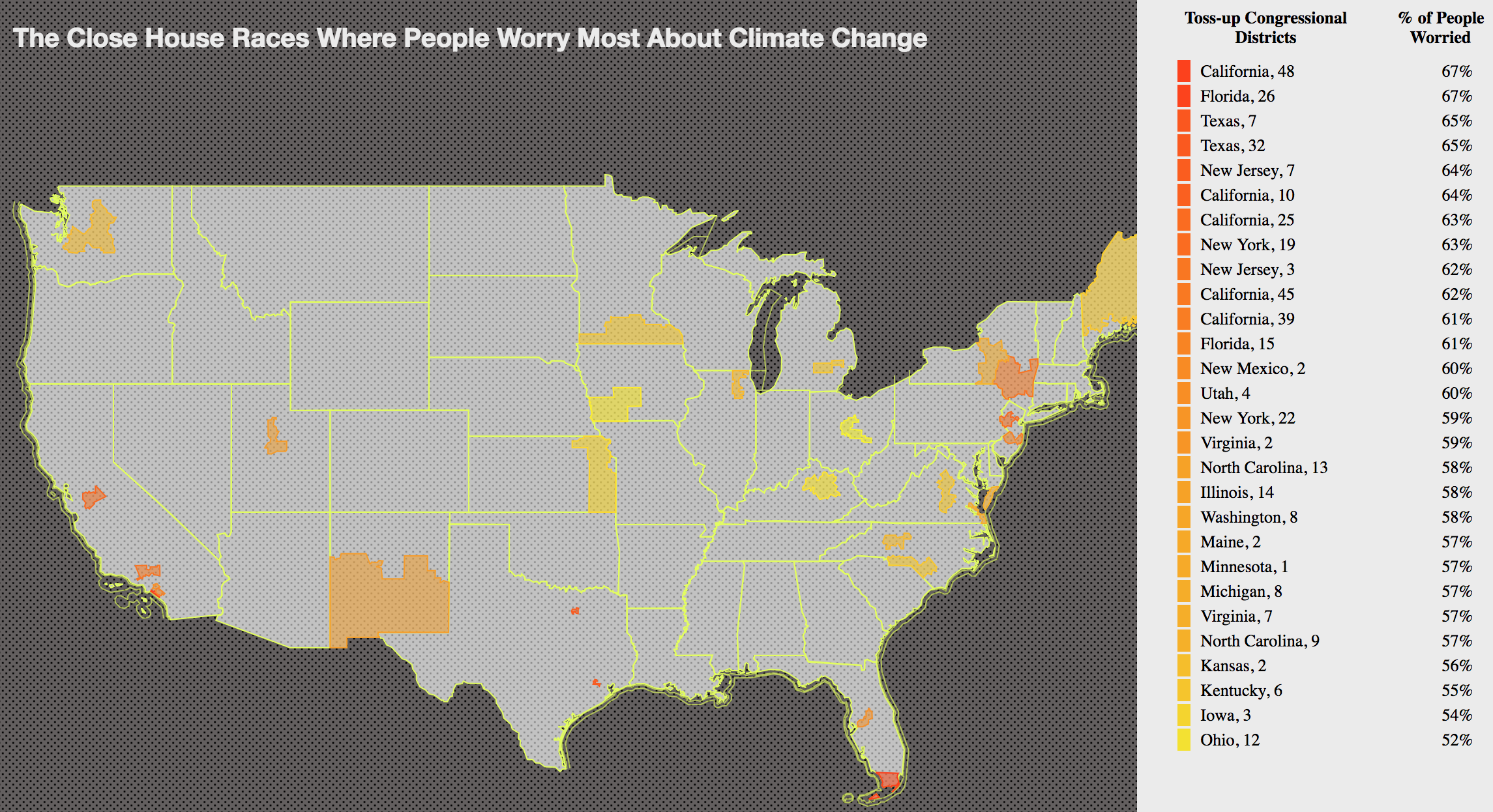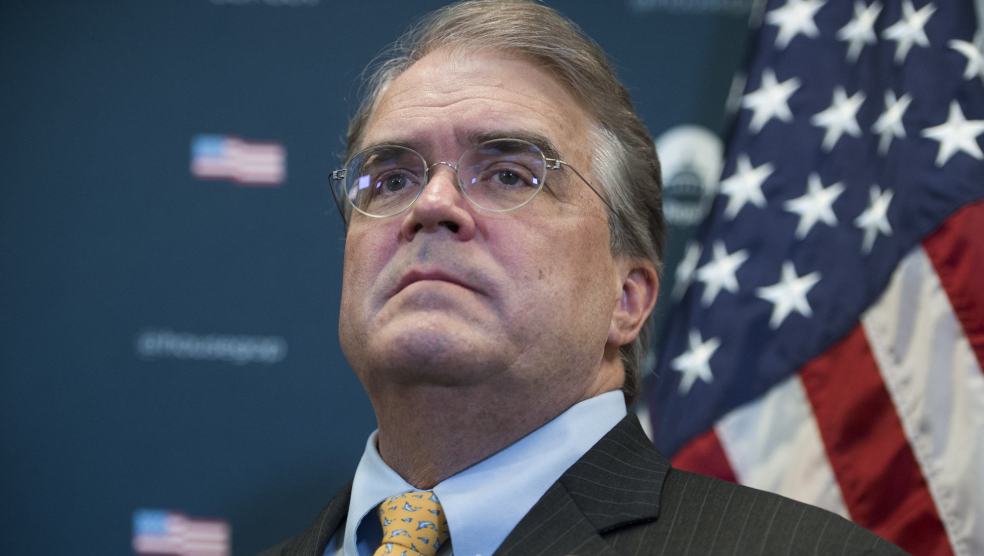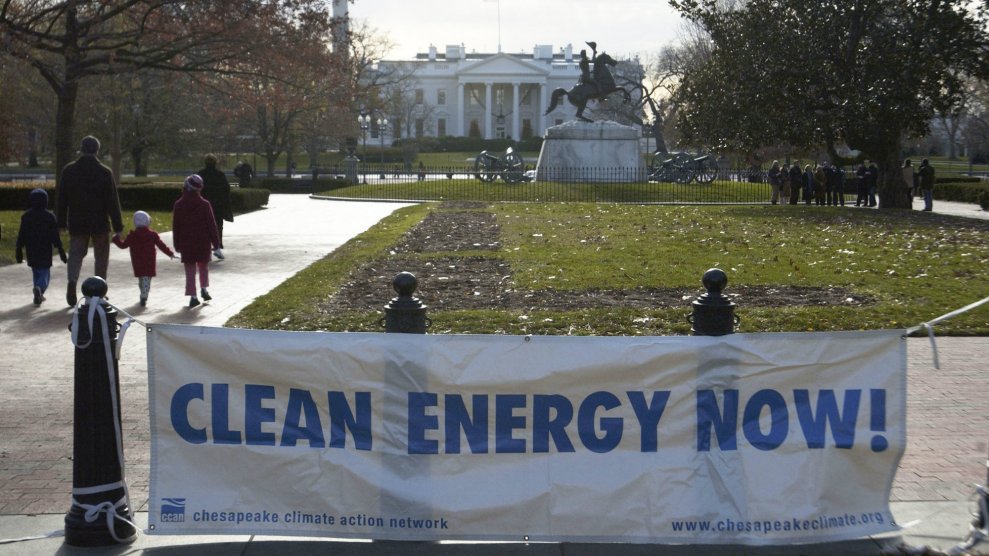
Amelia Bates/Grist
This story was originally published by Grist. It appears here as part of the Climate Desk collaboration.
Earlier this fall, the world’s top climate scientists gave humanity about 10 years to avoid a future that really sucks. With the midterm elections right around the corner, that warning means voters are effectively deciding which candidates to trust with the keys to the climate. If voters are sufficiently worried about warming, that anxiety might help determine who is put in office.
According to Anthony Leiserowitz, director of the Yale Program on Climate Change Communication, worry is a stronger predictor of policy support than other emotions. “We found that it’s not fear, it’s not anger, and it’s not disgust or guilt,” he explained. “Worry doesn’t hijack, doesn’t overwhelm, rationality. It can really spur it.”
So just how worried about the planet’s future are voters in the nation’s tightest congressional races? Grist created a map overlaying competitive elections, as identified by The Cook Political Report, with climate concern data from Yale’s 2018 Climate Opinion Maps.
These toss-up elections are spread throughout the country. Some are sprawling rural districts, others are comprised primarily of dense cities or metro areas. (Keep in mind that congressional districts vary in size, but each holds roughly the same number of people.) Each district varies in what percentage of its constituents report being worried about climate change—represented from yellow (not that worried) to red (pretty worried).

Interestingly, even in those districts where folks seem less concerned about climate change, a majority of people worry about it. Most of the seats in play are currently held by Republicans. And while several Democrats have doubled down on environmental policies, like renewable energy, climate change is a bipartisan issue in many of these communities.
Look closely at the map, and you’ll see a handful of neck-and-neck races in places chock full of climate-worriers. These communities range from the beaches of Miami and Southern California to the suburbs of Houston. Grist examined five of these highly climate-concerned toss-up districts to see what local factors may shift the balance of power in Congress.
Editor’s note: This map is based on up-to-date data at the time of publishing. Also, Grist‘s analysis excludes districts from Pennsylvania, because it recently redrew its congressional maps—and Yale’s data was collected before the redistricting effort. Sorry, Keystone State!
California 48th district (67 percent of residents are worried)
California’s 48th congressional district includes much of coastal Orange County, and the local midterms are about as melodramatic as an episode of The O.C.
Republican Dana Rohrabacher has represented this affluent, conservative bastion in a deep-blue state since 1989, but his seat is in play due in part to a few recent scandals: He had more than one clandestine meeting with Marina Butina, the former NRA darling arrested on suspicion of Russian espionage and election interference. That’s landed him on the radar of the Mueller investigation—and in hot water with voters. “They call me Putin’s best friend,” he told ABC last year. “I’m not Putin’s best friend.”
But even Republicans who deny Russian entanglements can’t get away with denying climate change in this sea-level community. The district’s stunning coastlines—from Huntington Beach to Laguna Beach—could see chronic flooding by 2030. That science isn’t lost on homeowners in the area, says Ray Hiemstra, co-chair of the Sierra Club’s Angeles Chapter Political Committee. “They’re actually starting to think, ‘Maybe I should start thinking of selling my place.'”
Rohrabacher says he supports solar and nuclear energy, as well as expanding oil and gas production. The staunch Trump supporter has stated in the past that offshore drilling is safer than importing oil on tankers, pointing to incidents such as the 1984 American Trader spill. In contrast, his opponent, Democratic candidate Harley Rouda, says he’ll promote clean energy while pushing back on offshore drilling efforts.
Florida 26th district (67 percent are worried)
The tides are already lapping at the door in the low-lying Florida Keys. Within the century, scientists predict that much of South Florida could be underwater.
It’s no wonder that residents in Florida’s 26th congressional district—the state’s southernmost region which includes all three of its national parks, as well as part of Miami-Dade County—are some of the Americans who are most concerned about climate change in the nation. Almost 70 percent of its constituents are Latino, most of them Cuban-American. Polls show that Latinos consistently want climate action more than the population at large.
So what are people most concerned about? In addition to king tides, Elizabeth Bonnell, chair of the Sierra Club’s Miami Group, points to “climate gentrification“—when developers buy up future beachfront properties in low-income neighborhoods, pushing out current residents. Then, there’s the stifling heat, toxic algae, and dangerous hurricanes that have been brewing in the Atlantic recently.
Incumbent Carlos Curbelo is one of only a handful of Republicans to openly address climate change. In February 2016 he co-founded the bipartisan Climate Solutions Caucus, which earned him a spot on the 2017 Grist 50 list. But this year, in the wake of Hurricane Michael, Curbelo called people who linked the historic storm, which intensified rapidly thanks to the Gulf of Mexico’s warmer-than-normal waters, climate change “alarmists.” The stance earned him some criticism.The seat is one of the top 10 House races to watch in 2018, according to Politico. But District 26 is a special place where both candidates running for the House seat—yes, including the Republican—have explicitly backed climate action.
“Those of us who truly care about #climatechange must be sober when discussing its connection to #HurricaneMichael or any other storm,” Curbelo tweeted. “Florida has had hurricanes for centuries. There’s no time to waste, but alarmists hurt the cause & move our fight for #climatesolutions backward.”
One week out from the election, the race is narrowing. And Democratic challenger Debbie Mucarsel-Powell, a former associate dean at Florida International University, has made the environment a key component of her political ads.
Texas 7th district (65 percent are worried)
The Texas 7th is affluent, well-educated, largely residential—and as a result of Hurricane Harvey, still recovering from being underwater for a chunk of 2017.
While the east side of Houston has long been infamous for its oil and gas infrastructure, the more affluent west side is becoming increasingly vulnerable to climate change in the form of freak storms. It has suffered extensive flooding from Harvey and at least two other storms in the past five years.
Republican John Culberson has represented Texas 7th since 2001. As he faces a tough reelection this year against Democratic challenger Lizzie Pannill Fletcher, he’s largely avoided talking about climate change, including declining an invitation in January to a community climate forum held in his district. While he has eschewed those exact words during his re-election bid, Rep. Culberson has used last year’s hurricane as a major talking point, name-dropping the storm in more than half of his emails to voters this year.
“He hasn’t been one of the snowball throwers calling climate change a hoax,” said Daniel Cohan, an environmental engineering professor at Rice University. “But he takes a wait-and-see attitude, falsely indicating that the science isn’t clear.”
For a district that’s borne the brunt of so many environmental disasters, it’s unclear how much sway climate change will have over the results of this race. According to Mark Jones, a political scientist at Rice University’s Baker Institute for Public Policy, there may not be enough swing voters in the Texas 7th who care about the issue. Those that do care already know how they’re voting. But Jones adds, there are “not an insignificant number” of voters who are still grappling with Harvey and could be potentially influenced by talk of climate policy.
Read more coverage on how climate politics are playing out in west Houston.
Texas 32nd district (65 percent are worried)
Texas has a lot of skin the game when it comes to climate change. A National Oceanic and Atmospheric Administration (NOAA) scientist once dubbed the state “the disaster capital of the United States” for its unique meteorological conditions.
Texas’ 32nd congressional district, which includes the suburbs northeast of Dallas, saw unprecedented rains and flooding in September and October. The storms led to multiple deaths in the Dallas area. An extreme drought and heat wave this past summer resulted in a remarkable uptick in heat-related hospital visits.
Like Texas overall, the 32nd is a “majority-minority” district: 49 percent white, 25 percent Latino, 15 percent black, and eight percent Asian. Environmental polls have shown that people of color are more likely to care about climate change compared to white people. And the district’s demographics are now colliding with extreme weather to drive climate concern.
At least for now, climate politics in the 32nd—which is more affluent than much of the state—are traditionally partisan. Pete Sessions, the incumbent Republican who’s represented the district (and its previous incarnation, District 5) since 1997, has a lifetime score of two percent from the League of Conservation Voters, indicating a strong anti-environment record. Sessions’ campaign platform includes “reining in the EPA” and opening public lands for drilling. When Sessions was questioned early last year about his support for controversial EPA head Scott Pruitt, he hanged the subject, putting the blame on New York and the Northeast for polluting America.
Sessions’ main opponent, Democrat Colin Allred, is an ex-football player and current civil rights attorney whose main focus is on reducing voter disenfranchisement. His environmental platform states he believes in promoting investment in renewable energy, “rejoining” the Paris climate accord, and defending the independence of the EPA and NOAA.
New Jersey 7th district (64 percent are worried)
New Jersey’s 7th congressional district stretches from New York City’s western suburbs all the way to the banks of the Delaware River. Not only does the river serve as the water supply for more than 15 million Americans, but it’s also a source of considerable climate worry for constituents.
Polluted runoff finds its way into waterways which add to the district’s rising rivers, damaging families, homes, and businesses. Climate change-related flooding threatens the quality of life across the district according to Ed Potosnak, executive director of the New Jersey League of Conservation Voters. “That’s where lack of action by Congress has left families vulnerable,” he told Grist.
New Jersey is the most densely populated state in the U.S., and the district runs the socioeconomic gamut, with a mix of suburban, exurban, and rural communities.
Republican Congressman Leonard Lance has represented the district since 2009. He’s also a member of the Climate Solutions Caucus. Though Lance has been a rare voice espousing the reality of climate change within the GOP, he also has a track record of siding with big business and the fossil fuel industry on legislation. Lance has a lifetime score of 23 percent on the League of Conservation Voters’ scorecard, hardly the marks of an environmentalist.
Lance’s opponent, Democrat Tom Malinowski, is new to New Jersey, but not to politics. He served as Assistant Secretary of State for Democracy, Human Rights, and Labor under President Obama. According to the League of Conservation Voters, he has dedicated his career to people’s rights to breathe clean air and drink clean water. Like his opponent, Malinowski has stated he believes that humans are exacerbating climate change. He has promised to oppose pipelines that will run across the state and has spoken out against offshore drilling
Additional Reporting Credit:
Map development: Lo Benichou (Mapbox)
Map data: The Cook Political Report and Yale’s 2018 Climate Opinion Maps (as of 10/30/2018)
Community profiles: Justine Calma, Kate Yoder, Stephen Paulsen, Eve Andrews, Paola Rosa-Aquino











